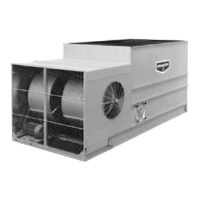6
7. Adjust fan belt tension as required. See “Fan Belt Adjustment” section.
8. Lubricate fan sha bearings prior to seasonal start-up.
9. Turn the fan(s) and pumps by hand to insure it turns freely without obstructions.
10. Visually inspect the fan blades. Blade clearance should be approximately 3/8” (1/4” minimum) from tip of blade to the
fan cowl. The fan blades should be securely tightened to the fan hub.
1
1. If any stagnant water remains in the system including “dead legs” in the piping, the unit must be disinfected prior to the
fans being energized. Please refer to ASHRAE Guideline 12-2000 and CTI Guideline WTP-148 for more information.
12. Manually fill the cold water basin up to the overflow connection.
13. For closed circuit coolers, fill the heat exchanger coil with the specified fluid and “burp” air from the system before
pressurizing, using vents on coil inlets. Do not do this for evaporative condensers.
NOTE: Closed circuit coolers should only be used on sealed, pressurized systems. Continual aeration of the water in an open
system can cause corrosion inside the tubes of the cooler leading to premature failure.
For closed circuit coolers with optional controls, see controls O&M for proper start up procedure.
Aer the unit has been energized, check the following:
1. Adjust mechanical float valve as required to the proper water level.
2. Unit basin should be filled to the proper operating level. See “Recirculating Water System Operating Levels” section for
more details.
3. Verify fan(s) is rotating in proper direction.
4. Start the spray water pump(s) and check for proper rotation as indicated by the arrow on the front cover.
5. Measure voltage and current on all three power leads of pump and fan motor. The current should not exceed the
motor nameplate full load amp rating taking the service factor into account.
6. Consult your qualified water treatment company to fine tune the minimum bleed necessary, see “Water Treatment and
Water Chemistry” section.
7. See fan and pump motor manufacturer maintenance and long term storage instructions for more detailed information.
The motors should be lubricated and serviced in accordance with manufacturer’s instructions.
8. All new evaporative cooling equipment and associated piping should be pre-cleaned and flushed to remove grease,
oil, dirt, debris and other suspended solids prior to operation. Any pre-cleaning chemistry should be compatible with
the cooling equipment’s materials of construction. Alkaline formulations should be avoided for systems which include
galvanized materials of construction.
Closed hydronic systems connected to either a closed-circuit cooler or dry cooler should be pre-cleaned and flushed
to remove debris, grease, flash rust, oil, and other suspended solids prior to operation. Evapco recommends the use of
inhibitor chemistry or inhibited glycol to minimize corrosion and scale during normal operation. EVAPCO recommends
a minimum of 25% inhibited glycol to minimize corrosion.

